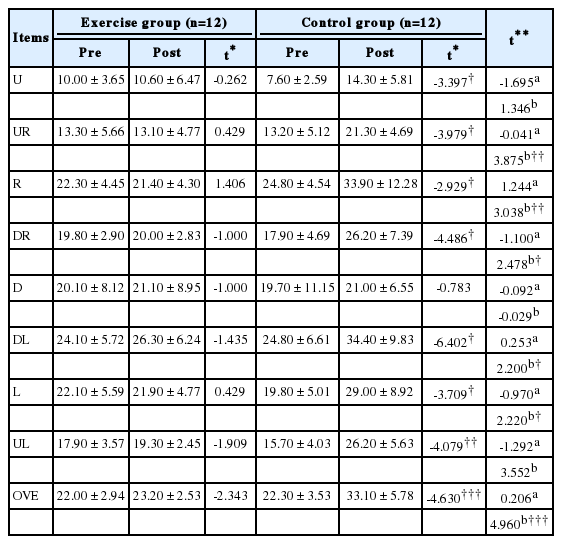코어 안정화 운동이 테니스 동호인의 평형력 및 동적균형능력에 미치는 영향
Effects of Core Stability Exercises on the Improvement of Counter Balance and Dynamic Balance Abilities of Tennis Club Members
Article information
Trans Abstract
PURPOSE
The purpose of this study is to identify the influence of core stability exercises on the counter balance and dynamic balance ability of tennis club members and to provide the basic data for developing the training methods for improving the athletic performance and injury prevention through physical imbalance.
METHODS
In order to achieve these goals, 12 subjects who are currently registered as a player in the having 5 years or more athletic career. As a result of observing improvements on counter balance and dynamic balance ability using the core stability exercises, the following conclusion was derived.
RESULTS
As for the counter balance ability, there were no significant differences between pre- and post-values in the exercise group after completing the core stabilization program. As for the dynamic balance ability, there were significant differences between pre- and post-values in the exercise group, except for down (D) postures, whereas, there were no changes or decreases between pre- and post-values in the control group after completing the core stabilization program. Meanwhile, in the aspect of comparisons between post-values in both groups, there were significant improvements in up-right (UR), right (R), down-right (DR), down/left (DL), left (L), up/left (UL), and overall dynamic scores (OVE) of the exercise group. In the aspect of comparisons between post-values in both groups, there were significant improvements in only the exercise group.
CONCLUSIONS
When concluding the results of this study, it was found that core stability exercises was an effective exercise in the improvement of counter balance and dynamic balance ability of tennis club members. In addition, in order to have precise and stable movements through stabilization of position improvement of physical imbalance, it is thought to require a suitable training development for tennis club members along with repetitive training.
서 론
생활체육 활동은 국민의 건강증진을 목적으로 신체적 능력의 발달과 여가선용으로써 자발적으로 참여하는 평생교육의 일환으로[1], 선진국들은 생활체육의 가치와 중요성을 인지하고 자국민의 체력향상과 복지를 위하여 정책적으로 지원하고 있다[2].
생활체육으로 테니스는 다양한 스포츠 종목 가운데 축구 다음으로 매우 높은 위상을 지니고 있으며[3], 대중 스포츠로써 테니스는 동호인들에게 단순히 건강한 삶을 영위하고 체력을 단련하는 차원을 초월하여 다양한 기술과 경기위주의 경쟁방식을 통해 여가를 즐기도록 한다. 동호인 테니스 단체인 국민생활체육 전국테니스 연합회와 한국 동호인 테니스협회(KATA), 한국 아마추어 테니스 연합회(KATO)에서 동호인의 랭킹제를 실시하고 있어, 이는 한국형 생활체육 테니스의 독특한 문화를 형성하는 기초가 되고 있다[4]. 테니스는 지속적인 움직임과 빠른 몸놀림, 그리고 경기 상황에 따른 판단력과 순발력을 필요로 하며 장시간 운동 수행을 할 수 있는 지구력과 민첩성 및 기술과 전술이 요구되는 특성을 지닌 종목이다[5,6]. 그 중 신체 밸런스는 경기력에 중요한 요인으로 알려져 있으며, 경기 시 상황에 가장 적절하게 대처할 수 있는 위치를 점하는 움직임과 무게중심을 유지하는 중요한 역할을 한다. 이를 위해서는 선수들이 적절한 풋워크(Foot work)로 타구지점으로 이동함과 동시에 타구의 전 과정을 통해 이상적인 밸런스를 유지하는 것이 필요하며 일상적인 훈련을 수행하는 과정에서 자신의 신체 위치나 자세를 조절하는 방법을 연습해야 한다[7]. 또한, 테니스는 매샷(shot)의 볼의 속도와 회전율, 코트의 상황이 각기 다르므로, 연속적인 긴장 상태의 게임으로써 묘사되며, 테니스 경기에서의 움직임 동선은 직선뿐만 아니라 측면, 다방면으로 민첩한 움직임을 가질 필요성이 있다고 하였다[6]. 또한, 방향전환을 빠르게 해야 하는 테니스의 특성상 민첩성이 중요한 가운데, 동작을 연속시키기 위해 도중에 신체의 평형을 잃게 되면 정확하고 빠른 운동의 연속이 어려워지므로, 평형성과 밀접한 관련이 있다[8]. Krampe et al. [9]은 성공적인 운동 실행을 위해서 필수적인 요소 중 하나로써 평형성을 강조하였고, 전반적인 체력에서 근력이나 유연성만큼 평형성이 중요한 기초체력 요인임을 알 수 있다고 하였다[10]. 그리고 빈약한 평형성은 운동경험자들 사이에 손상 발생을 높이는 체력요인이며, 평형성 향상을 위한 플라이오메트릭 트레이닝과 같은 신경근 트레이닝 프로그램은 손상 예방의 수단으로써 채택되어야 한다[11].
코어 안정화 운동은 분절간 분절내 협응성을 최대로 할 수 있는 운동이며, 부하가 인체의 요추와 천추를 교차하여 전위될 수 있는 능력을 촉진시키는 운동이다. 또한, 연속적인 분절운동을 하기 때문에 발 끝에서부터 몸통에 이르기까지 통합적인 시스템을 증진시키며, 이중에서 불안정한 표면에서의 운동에서 근육으로의 신경작용이 증가하고, 운동단위의 동일화가 증가되며, 근육의 상승작용에 의한 활동이 증가하며 복합관절 주변의 안정성 또한 증가한다[12]. 이는 더 많은 근섬유를 동원시키기 때문에 근력이 증가하고 근육 내 협응력이 향상된다고 보고하였다[13]. 코어 안정화를 유지하기 위해서는 척추 주위의 근육들을 작용하도록 하는 신경조절 조직의 상호작용이 필요하게 되며[14], 신경근기전은 움직임이 없을 때와 움직이는 동안 신체의 균형을 조절하는 데 중요한 역할을 한다. 신경근 효율은 힘을 감소시키고, 동적으로 안정시키며 이때 세평면의 움직임에서 전체 운동 사슬을 통해 힘을 만들어 내는데, 신경근 효율이 높을수록 주동근의 높은 참여를 가능하게 하고 길항근으로부터 신경억제를 낮게 한다[15].
이와 같이 테니스는 신체불균형을 초래하는 대표적인 편측성 운동으로 이로 인한 스포츠손상의 위험이 매우 높다. 또한, 테니스 기술은 아주 정교하고 감각적인 운동으로서 기본자세의 안정화가 이루어지지 못할 경우 전문적인 체력 및 기술을 활용할 수 없다. 이에 테니스종목은 전문적인 체력과 기술동작의 안정화를 위한 특이적 훈련방법이 필요하다.
따라서 코어 안정화 운동을 통한 평형성과 균형능력향상은 테니스 동호인들에게 있어서 매우 중요한 체력적 접근방법이다. 즉, 코어 안정화 운동을 지속적으로 적용한다면 테니스 동호인의 신체불균형으로 인한 부상예방과 신체안정화에 도움이 되리라 기대한다. 따라서 본 연구는 테니스 동호인을 대상으로 12주간 코어 안정화 운동이 평형력과 균형능력에 미치는 효과를 검증하고자 한다.
연구 방법
1. 연구 대상
본 연구는 2015년 9월부터 12월까지 D시에 거주하는 운동경력 5년 이상인 남성 테니스 동호인을 대상으로 실시하였다. 본 실험의 취지를 충분히 이해하고 실험에 대한 자발적인 참여의사를 가진 피험자 24명을 선정하였다. 피험자들의 신체적 특성은 Table 1과 같다.
2. 코어 안정화 운동 프로그램
본 연구에서 적용하고자 한 코어 안정화 운동은 필라테스 매트운동 프로그램은 조셉 필라테스의 기본동작을 기초로 구성하였으며 Hur [16], Kwon et al. [17]의 선행연구를 바탕으로 ACSM [18]에 제시되어 있는 운동 권장량을 준수하여 준비운동 10분, 본 운동 40분, 정리운동 10분으로 총 60분간 실시하였다. 운동은 주 3회의 빈도로 12주간 적용하였다. 매트운동 동작들의 움직임의 범위 및 횟수를 증가시키면서 운동 강도를 증가시키는 점증적 운동부하 원리를 적용시키면서, 설정된 최대 운동 강도가 벗어나지 않도록 구성하였다. 또한 각 동작을 수행하는 데 있어 정확성보다 안전성에 중점을 두어 선수들이 따라 하기 힘든 동작 부분에서는 다소 변형된 운동을 제공하였다. 구체적인 내용은 Table 2와 같이 구성하였다.
3. 측정 항목 및 방법
1) 평형력 검사
평형력 측정은 Humac Norm Balance System (CSMI, Boston, US)의 Center of Pressure 측정법과 Weight Bearing 측정법으로 평형능력을 측정하였다. 피험자는 밸런스 보드 위에 올라서서 스크린을 응시하며 원형중심의 중앙점에 압력을 가하여 균형을 잃지 않고 지속적으로 오래 서있는 방법으로 전측, 후측, 좌측, 우측방향으로 중심이동에 따라 평균값이 변하며 중심을 잡고 서있는 시간을 측정하여 그 결과 값으로 나타낸다.
2) 동적 균형능력 검사
동적 균형능력 측정은 Humac Norm Balance System (CSMI, Boston, US)의 Limits Of Stability (LOS)기록을 통하여 밸런스 능력을 측정한다. 피험자는 밸런스 보드 위에 올라서서 스크린을 응시하며 원형중심에서 무작위 방향으로 점멸되는 표지방향으로 밸런스 보드 위에서 압력을 가하며 균형을 잃지 않고 지속적으로 밸런스 능력을 측정하는 방법으로 총 8개 방향(UP, UR/Right, Right, Down/Right, Down, Down/Left, Left, UP/Left, and Overall )과 9개 변인의 이동시간과 지속 시간을 측정하여 그 결과 값으로 나타낸다.
4. 자료처리 방법
본 연구의 자료처리는 SPSS 20.0 (Window statistical package)을 이용하여 수집된 모든 자료의 평균 및 표준편차를 산출 후, 집단 내 실험 전후의 유의성 검정을 위해 대응표본 t검증(Paired t-test)을 실시하였으며, 집단 간 실험 전후의 유의성 검정을 위해 독립표본 t검증(Independent sample t-test)을 실시하였다. 이때 유의수준은 p< .05로 하였다.
연구 결과
1. 평형력의 변화
코어 안정화 운동에 따른 평형력의 변화는 Table 3과 같다. 코어 안정화 운동 전후 그룹별 평형력에 관한 연구에서 운동그룹은 Up, Down, Left, Right의 평형력은 증가하였으나 유의한 차이가 없었다. 또한, 그룹 간 차이에서도 유의한 차이가 나타나지 않았다.
2. 동적균형능력의 변화
코어 안정화 운동에 따른 동적 균형능력의 차이는 Table 4와 같다. 코어 안정화운동 프로그램을 실시한 운동그룹의 경우 사전과 사후에 대한 변화에 있어 하측(D)의 균형능력만을 제외하고는 모든 자세에 있어 유의하게 개선된 반면, 통제그룹에 있어서는 유의한 변화가 없거나 동적 균형능력이 감소한 것으로 나타났다. 한편, 동적 균형능력에 대한 집단 간의 차이는 상측(U), 하측(D)을 제외한 모든 자세에서 유의한 변화가 있었으며 전체 스코어가 통제그룹에 비해 운동그룹에서 유의하게 향상된 것으로 나타났다.
논 의
본 연구에서는 코어 안정화 운동이 테니스 동호인의 평형력 및 동적 균형능력 변화에 미치는 영향을 확인하기 위해 트레이닝 전후 평형력(Up, Down, Left, Right) 및 동적 균형능력(Up, Up/Right, Right, Down/Right, Down, Down/Left, Left, Up/Left, OVE/Overall)의 변화를 측정하였다. 측정값을 분석한 결과, 평형력에 관한 연구에서 운동그룹은 Up, Down, Left, Right의 평형력은 증가하였으나 통계적으로는 유의한 차이가 없었다. 또한, 그룹 간 차이에서도 통계적으로 유의한 차이가 나타나지 않았다. 이는 Norm Balance System의 Weight Bearing 측정방법이 원형 중심에 지속적으로 오래 중심을 잡고 있는 측정방법의 특성상 운동그룹과 통제그룹 모두 통계적으로 유의한 차이를 보이지 않았으나 수치상으로 운동그룹이 운동 전과 비교하여 개선된 효과를 보였다. 이는 균형 훈련이 외발서기 균형능력 평가에 효과적인 향상을 보인다[19,20]는 연구결과와 일치하였으며 테니스 선수를 대상으로 균형운동을 실시한 결과 균형능력이 유의하게 향상되었다고 보고한 Kim [21]의 연구결과와 일치하였다. 또한, 일반인을 대상으로 코어 강화 운동을 실시한 결과 자세 안정성과 정적 균형능력이 향상된 것으로 보고한 Stivala et al. [22]의 연구 결과를 뒷받침하는 결과이다.
동적 균형능력에 관한 연구에서는 프로그램을 실시한 후 운동그룹은 하측(D)의 균형능력만을 제외하고는 모든 자세에 있어 유의하게 개선되었으며 동적 균형능력에 대한 집단 간의 차이는 상측(U), 하측(D)을 제외한 모든 자세에서 유의한 변화가 있었고, 전체 스코어(Overall)가 통제그룹에 비해 운동그룹에서 유의하게 향상된 것으로 나타났다. 이는 테니스 선수를 대상으로 균형 운동을 실시한 결과 균형능력이 유의하게 향상되었다고 보고한 Nam et al. [23]의 연구결과와 일치하였으며 양궁선수를 대상으로 코어 안정화 운동을 실시한 결과 균형능력의 향상에 영향을 주었다는 Kim [24]의 연구와 프로 골퍼를 대상으로 한 코어 안정화 운동이 골퍼들의 균형 능력에 영향을 주었다는 연구결과[25]와 일치하였다. 또한, 테니스 선수에게 균형 및 유연성 운동 프로그램을 실시하여 균형능력 향상의 결과를 보고한 연구결과[26,27]를 뒷받침 하는 결과이다.
이러한 코어 안정화 운동은 인체 부위에서 복부와 허리부위는 파워존(power zone)이라 할 정도로 사지가 힘을 발휘하고, 큰 힘을 낼 수 있도록 해주는 근원지이며, 또한 신체의 기능적 안정성을 유지하기 위해 요추부위 주변 근육들의 근 신경 조절이 중요하게 작용을 하며[28] 이를 통한 신체의 긴장해소와 유연성 증대와 자세를 교정하고, 운동 시 부상의 위험도 줄여주는 장점이 있다[29]. 이러한 코어 근육(core muscle)은 척추와 복부 주위의 근육들로서 코어 근육의 안정성은 척추, 골반 등의 균형적인 움직임을 위해 필수적이며, 인체의 안정성과 움직임을 위해서도 코어근육들의 협응이 중요하게 작용하기 때문에[30] 많은 스포츠의학자들이 손상을 예방하고 운동 수행력을 향상시키기 위해 코어 근육에 대한 근력 트레이닝을 적용해왔고 코어 근력이 강한 선수들이 운동 수행력도 좋다는 인식은 보편화 되어왔다[31]. 이러듯, 코어 기능의 중요성은 몸통의 회전 및 강한 임팩트로 인해 지속적으로 코어 근육이 사용되는 테니스 선수에게는 코어 부위의 강화는 기술 발휘는 물론 경기력 향상을 위해서도 우선적으로 갖추어져야 할 요인이라고 하였으며, 강한 체력과 빠른 판단력 및 순발력을 필요로 하는 테니스 선수에게 균형능력은 중요한 요소이다[24].
본 연구결과 균형운동으로서의 코어 안정화 운동보다 테니스의 다양한 기능을 수행할 수 있는 복합트레이닝이 더 효율적인 결과를 줄 수 있을 것으로 생각된다. 또한, 안정화된 자세유지와 동작을 하기 위해서는 반복적인 훈련과 더불어 테니스 동호인에 적합한 트레이닝 개발이 요구된다.
결 론
코어 안정화 운동 프로그램 전후 그룹별 평형력에 관한 연구에서 운동그룹의 평형력은 Up, Down, Left, Right의 평형력은 증가하였으나 통계적으로는 유의한 차이가 없었다. 또한 그룹 간 차이에서도 통계적으로 유의한 차이가 나타나지 않았다.
코어 안정화 운동 전후 운동그룹의 균형능력은 하측(D)의 균형능력만을 제외하고는 모든 자세에 있어 유의하게 개선되었으며, 동적 균형능력에 대한 집단 간의 차이는 상측(U), 하측(D)을 제외한 모든 자세에서 유의한 변화가 있었다. 또한 전체 스코어(OVE)가 통제그룹에 비해 운동그룹에서 유의하게 향상된 것으로 나타났다.
본 연구를 종합해 볼 때, 코어 안정화 운동은 테니스 동호인들의 평형력과 균형능력에 효과적인 운동임을 확인할 수 있었다. 또한 신체불균형 개선과 자세의 안정화를 통해 세밀하고 안정화된 동작을 하기 위해서는 반복적인 훈련과 더불어 테니스 동호인에 적합한 트레이닝 개발이 요구되는 것으로 생각된다.



